News
Article
Pharmaceutical Technology Europe
Pharmaceutical Technology Europe
Testing Inhalers
Author(s):
This article investigates how the industry can test inhalers in a way that is most representative of typical use.
One of the longstanding challenges facing the United States Pharmacopeia (USP) is the necessity to provide guidance for testing standards that are representative of typical use. The USP maintains a formal revision process, which is reliant upon 'substantial interaction' between their stakeholders (the public, and scientific and technical groups) and their Council of Experts. As engineers and scientists working within the field of respiratory drug delivery, it is up to us, therefore, to challenge existing testing methodologies, and strive to constantly reduce the gap between results produced within the laboratory to those acquired in clinical studies.
Passive dry powder inhalers (DPIs) rely solely upon the inspiratory effort provided by the patient to produce a respirable aerosol. Historically, DPIs have been used to administer medication for the direct treatment or relief of chronic obstructive pulmonary disease (COPD) and asthma. People who suffer from either of these, characteristically, have impaired lung function and are less able to inhale forcefully through an aerodynamically resistive DPI. Studies researching the lung power of these groups report that a flow rate of 60 L/min can typically be achieved through a medium resistance device (corresponding to a pressure drop across the device of 4 kPa).1 I However, a new generation of DPIs is under development to cover a range of diseases and illnesses, including the systemic delivery of a wide range of molecules to treat conditions such as diabetes, pain management, allergic reactions and sexual dysfunction. In addition, numerous pharmaceutical companies are developing inhalable vaccines to overcome problems associated with parenteral administration, such as needle-stick injury and the requirement for refrigeration of the vaccines throughout the shipping cycle. There are two distinct advantages of delivering drugs directly into the lungs:2
- There is a high rate of absorption into the bloodstream, resulting in a fast onset of relief.
- A reduced chance of drug metabolism occurring, meaning delicate molecules can be delivered that would normally be administered parenterally.
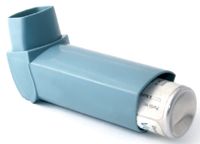
People who suffer from these aforementioned illnesses will not necessarily have impaired lung function. The current test point of a 4 kPa pressure drop across the DPI is unlikely to be representative of what will be achieved in typical use.
As engineers and scientists responsible for the development of DPIs to treat a range of conditions, we should believe that an in-depth understanding of the nature of the lung power of the target therapeutic group is prerequisite to achieving a successful inhaler design. Only once armed with this information can we expect to achieve clinical results that marry well to those generated within the laboratory.
Usefully measuring lung power
There is little published literature available on the measurement of lung power — most research has been conducted using inhaler devices with fixed resistances, each inhaler representing just a single datum on a lung power profile. Also to be considered is the relatively short duration of an inspiratory manoeuvre — usually less than 2 s; half that of the prescribed test duration by the USP for a medium resistance inhaler.3 Of course, this is considerably shorter as far as the drug is concerned as it will have typically exited the inhaler within 100–300 ms. In terms of developing a testing methodology, this means that a fast response time of the measurement instrumentation is required to capture the dynamic nature of the inhalation event.

Figure 1
A similar technique, albeit on a larger scale, is used to measure the power response of in-line centrifugal fan motors.4 I adapted this technique to work on a much smaller scale, to measure the pressure/flow temporal profiles of 16 healthy, adult volunteers (Figure 1). A low volume (~200 cm3) 'airwatts' box was designed to minimize capacitance effects and, using nine orifice plates, a wide range of inhaler resistances could be represented. Each orifice was pressure-mapped to determine its discharge coefficient, Cd, according to Equation 1, thus allowing flow rate to be accurately deduced from static pressure data. II
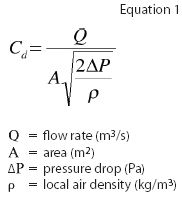
Each volunteer was asked to "breathe out gently, as far as is comfortable", then inhale through the airwatts box as "quickly, hard and deeply" as possible. This produces nine pressure and flow rate temporal profiles per volunteer (Figure 2).

Figure 2
To construct a power-flow rate profile, the peak flow rate must be calculated from each profile. Rather than simply take the absolute peak data, which may only last a few milliseconds, all data above 80% of the peak datum value were averaged (i.e., the top 20%), and this mean value taken to be the peak flow rate (or pressure) for that particular resistance. An example is illustrated by the purple triangles overlaid on the profile of Orifice 5 (Ø7.4 mm) (Figure 3). This was believed to be a more representative measure as it rules out spikes in the profile and is effectively the average peak period of the inhalation. The mean peak flow rate achieved by our example volunteer through Orifice 5 was 158.3 L/min, which is ~94% of the absolute peak value, 168.7 L/min. It is accepted that this method will slightly under predict the power of our volunteers' lungs.
Several parameters are captured simultaneously, including; pressure III airflow rate, power and airflow velocity IV, which was used to measure the power response of human lungs.
The first order derivative of these four parameters has been calculated using a straightforward linear regression of the data falling between 10% and 80% of the absolute peak datum on the positive slope of the profiles. An example is shown by the red diamonds, together with the dashed trend line, overlaid on the profile shown in Figure 3. The slope of this trend line is taken to be the peak rate of change for all of the measured parameters.
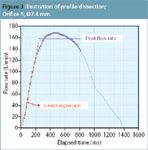
Figure 3
Once we have calculated peak pressure and peak airflow rate from each of the nine resistance profiles, we can derive airflow power, according to Equation 2. V

A known measure for inspiratory muscle strength is the maximal inspiratory mouth pressure, which is achieved against a closed shutter (zero airflow rate). Conversely, the peak inspiratory flow rate is reached with no additional resistance to the inhalation (zero pressure) (Figure 4). In accordance with Equation 2, the airflow power peaks somewhere between the extremes of pressure and airflow rate (Figure 5).
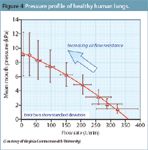
Figure 4
A key finding here is that the mean mouth pressure achieved by our group of healthy volunteers through a medium resistance device is approximately 8 kPa, resulting in a flow rate of 90 L/min and a power of 12 airwatts (Figure 5). This is double the pressure drop and triple the recommended power prescribed as the nominal test point for a medium resistance DPI by the USP. Further, an inhaler with a significantly lower resistance could run at almost 200 L/min, receiving 17 airwatts of power.7 VI
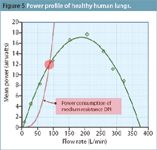
Figure 5
Important parameters
The USP instructs us to draw four litres of air through the DPI under evaluation at a flow rate (Qout) that produces a pressure drop of 4 kPa across the device, using a solenoid valve to start and stop the airflow.3 It is widely known (and accepted) within the industry that this method gives rise to a steep ramp-up in the flow profile through the inhaler, which is unlikely to be representative of patient use (Figure 6). Our healthy volunteers took approximately half a second to reach their peak inspiratory flow rate through the medium resistance orifice. A powerful vacuum pump, coupled to the inhaler with a low volume circuit and using a solenoid valve to trigger the airflow would have an almost instantaneous rise in the flow profile — clearly unrepresentative of typical use.
The ramp-up of the profile (pressure, flow rate and ultimately airflow velocity within the inhaler) is likely to have a strong influence on the aerosol performance characteristics of virtually all DPIs. This is because the majority of DPIs release their formulation within 100–300 ms, hence, any available energy beyond this time point will have no opportunity to do work on the drug formulation. A Malvern Spraytech laser diffractometer was used to demonstrate this effect (Figure 6).

Figure 6
Airflow acceleration in particular is likely to influence the aerosolization of drug formulation within the DPI. This is because the powder is initially at rest, and, therefore, the differential velocity (between the airflow and the powder) is maximum. The quicker the airflow can be brought up to peak velocity, the greater the differential velocity (because of the inertial lag of the powder), and thus, the larger the aerodynamic drag force exerted upon the particles. There is a strong correlation between airflow resistance and peak airflow acceleration (Figure 7). This immediately suggests that if the residence time of the drug formulation within the DPI is likely to be short, it will be beneficial to have as high a resistance inhaler as possible. It must be remembered, however, that airflow power was found to peak with an extremely low resistance (Figure 8). Without adequate power, the momentum of the airflow will be insufficient to aerosolize the formulation.
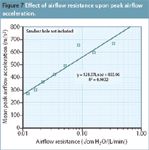
Figure 7
So what does it all mean?
Many factors contribute towards the performance of a passive DPI. During this pilot study evaluating a novel methodology to characterize human lung power response, it became apparent that these parameters are often in conflict with one another. For example, it may be advantageous for a particular DPI design to have extended inhalation event duration — yet this would limit the airflow power available. Similarly, an inhaler with high perceived user comfort (in our tests the users indicated a preference for low resistance) may have insufficient airflow velocity or acceleration to produce the required aerosol performance.
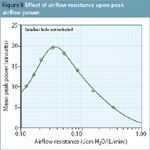
Figure 8
The design of an optimal passive DPI represents a balance of multiple trade offs (Figure 9). The most important conclusion we reached was that building an in-depth understanding of the energy available in the target therapeutic market is essential for the successful development of a passive DPI. This should include in vitro studies to establish the relative influence of these measured parameters upon the DPI under development, such that informed decisions can be made to pursue the optimal usage of the energy available.
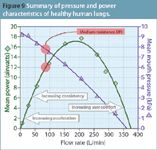
Figure 9
There is clearly dissimilarity between the way in which the airflow develops through a passive DPI in laboratory testing to typical patient use: patients, at least those who do not suffer from impaired lung function, may well achieve higher driving pressures than the 4 kPa recommended by the USP. However, they are unlikely to be able to match the steep ramp-ups produced by the vacuum pump/solenoid valve combination in vitro method. It is our intention, and indeed a strong recommendation for other interested parties, such as pharmaceutical or device development companies, to extend this study to cover a broader range of people, and to a statistically significant scale. An extensive data set would enable us to characterize the effect of these dissimilarities upon DPI performance and potentially improve the methodologies prescribed by the USP.

Key points
I. A 'medium' resistance inhaler device requires a pressure drop of 4 kPa to draw an airflow rate of 60 L/min. through it. As the resistance is given by the ratio of the square root of pressure drop to airflow rate, medium resistance is 0.105 -cm H2O/(L/min) (conventional units).
II. 200 cm3 is 5–10% of a normal adult's lung capacity. There must be sufficient volume to remove the dynamic head component of the airflow through the box, to measure static pressure accurately — but this must be traded off against having too high a volume, which reduces the responsiveness of the system to measure high rates of change in pressure or airflow rate.
III. Specifically 'mouth pressure'. The airwatts box method effectively measures the pressure drop that would be achieved within the mouth at any point during the inhalation event, and the subsequent airflow rate that will result through the resistance that is providing that pressure drop.
IV. The estimated peak velocity through the orifice, calculated as the ratio of the volumetric flow rate to the open cross-sectional area.
V. Airflow power is a reasonable approximation of airflow power in the measurement of human lung power as it assumes the air in incompressible. As the pressure drops are typically less than 10% of atmospheric, the changes in the density of the air can be considered negligible. As the air expands and contracts, there are small additional losses because of the energy lost in the process of heat exchange between the air and the surroundings.
VI. An inhaler requiring a pressure drop of only 0.6 kPa to draw 60 L/min through it would actually run at almost 200 L/min, at a pressure drop of just over 5 kPa — consuming 17 airwatts. This is a very low resistance inhaler, with R=0.04 Âcm H2O/(L/min. The only marketed inhaler with a resistance close to this value is the Rotahaler at R=0.046 -cm H2O/(L/min).
David Harris is a senior consultant at Cambridge Consultants and works in the drug delivery products group. He specializes in aerosol science, including fluid dynamics, electrostatics and their applications to inhaler technology.
References
1. A.R. Clarke and A.M. Hollingworth, J. Aerosol Med., 6, 99–110 (1993).
2. R. Uchenna et al., Respiratory Research, 2, 198–209 (2001).
3. United States Pharmacopeia 29, Physical Tests/<601>, Aerosols, pp 2620–2621.
4. BS EN 60312:1998, Vacuum cleaners for household use — Methods of measuring the performance, Sections 2.8 and 5.2.8, pp 18, 37–38, 50–52.
5. D. Harris, Respiratory Drug Delivery, 537–540 (2006).
6. J.P. de Koning, "Dry Powder Inhalation: Technical and Physiological Aspects, Prescribing and Use," Chapter 1: Introduction to Inhalation Therapy with Dry Powder Inhalers, Thesis, University of Groningen, Groningen, The Netherlands (2001), Section 1.8.
7. J.P. de Koning, "Dry Powder Inhalation: Technical and Physiological Aspects, Prescribing and Use," 'Chapter 3: Relationship between Inspiratory Flow Through Simulated Dry Powder Inhalers and Peak Maximal Inspiratory Pressure,Thesis, University of Groningen, Groningen, The Netherlands (2001), Section 3.1, 2001.

Newsletter
Get the essential updates shaping the future of pharma manufacturing and compliance—subscribe today to Pharmaceutical Technology and never miss a breakthrough.



